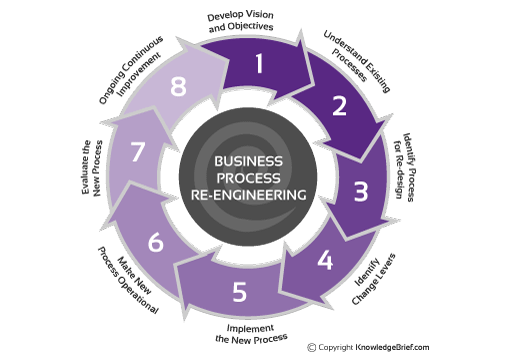Business Process Reengineering (BPR), a strategic approach to radically redesigning core business processes, has been further amplified by the advent of Generative AI and Cloud Computing. These technologies offer unprecedented opportunities to optimize processes, enhance decision-making, and drive innovation.
The Impact of Generative AI and Cloud Computing on BPR follows...
Business Process Reengineering (BPR) in the Age of AI and Cloud Computing
Business Process Reengineering (BPR), a strategic approach to radically redesigning core business processes, has been further amplified by the advent of Generative AI and Cloud Computing. These technologies offer unprecedented opportunities to optimize processes, enhance decision-making, and drive innovation.
The Impact of Generative AI and Cloud Computing on BPR
Generative AI has the potential to revolutionize BPR by automating tasks, generating creative solutions, and improving decision-making. By analyzing vast amounts of data, AI can identify patterns, trends, and anomalies that humans may miss. This enables organizations to make more informed decisions and optimize processes.
Cloud Computing provides the infrastructure and tools to support BPR initiatives. By leveraging cloud-based platforms, organizations can access scalable computing resources, data storage, and software applications, accelerating the implementation and adoption of new processes.
Key Areas of Impact:
- Process Automation:
- Robotic Process Automation (RPA): Automating repetitive tasks to reduce errors and increase efficiency.
- Intelligent Automation: Combining RPA with AI to handle complex tasks that require cognitive abilities.
- Decision Making:
- Predictive Analytics: Using AI to forecast future trends and make data-driven decisions.
- Prescriptive Analytics: Recommending optimal actions based on data analysis.
- Customer Experience:
- Personalized Experiences: Leveraging AI to tailor products and services to individual customer preferences.
- Improved Customer Support: Using AI-powered chatbots and virtual assistants to provide efficient and accurate support.
- Innovation:
- Idea Generation: AI can generate new ideas and concepts by analyzing vast datasets and identifying emerging trends.
- Rapid Prototyping: Cloud-based tools enable rapid prototyping and testing of new processes.
Challenges and Considerations:
- Data Quality and Privacy: Ensuring data quality and privacy is crucial for accurate AI-driven insights.
- Ethical Considerations: Addressing ethical concerns related to AI, such as bias and discrimination.
- Change Management: Effectively managing organizational change and employee resistance to new technologies.
- Security Risks: Protecting sensitive data and systems from cyber threats.
Conclusion
By embracing the power of Generative AI and Cloud Computing, organizations can significantly accelerate their BPR initiatives and achieve transformative results. By carefully considering the challenges and opportunities, businesses can position themselves for success in the digital age.
References:
- Davenport, T. H. (1993). Process Innovation: Reengineering Work Through Information Technology. Harvard Business Review Press.
- McAfee, A., & Brynjolfsson, E. (2017). Machine Platform Crowd: Harnessing Our Digital Future. W. W. Norton & Company.
- IBM. (2023). AI and Automation: The Future of Work. IBM.
- Gartner. (2023). Gartner Forecasts Worldwide IT Spending to Grow 1.5% in 2023. Gartner.
